|
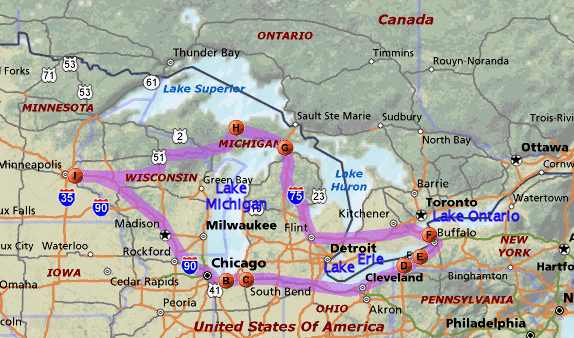
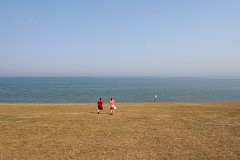
|
Wednesday August 1, 2007.
F - (near)Niagara Falls.
My children walk near Lake Ontario, the third Great Lake we have visited on
our Great Lakes Loop. Lake Ontario, the 14th largest lake in the world, is the smallest of the Great Lakes in surface area.
|
|
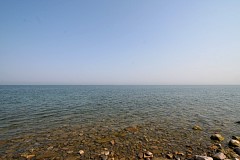
It's difficult to capture the nature of any one of the Great Lakes with just a photo or two.
The explorer Champlain first called Lake Ontario Lake St. Louis in 1632. In 1660, Creuxius gave it the name Lacus Ontarius. Reputedly, Ontara in Iroquois means "lake," and Ontario, "beautiful lake."
Lake Ontario lies 325 feet below the level of Lake Erie. Water flows from the other Great
Lakes through Lake Ontario and on to the ocean.
Niagara Falls were always an obstacle to navigation from Lake Ontario into the upper lakes until the Trent-Severn Waterway, along with the Welland and Erie Canals were built to allow ships to pass around this bottleneck.
|
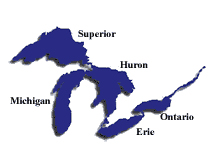
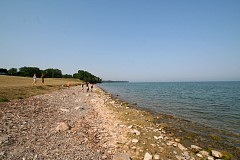
Lake Ontario is similar to Lake Erie in length and
breadth (193 miles by 53 miles). It has a maximum depth of 802 feet. Yet with its greater
average depth
(approximately 283 feet), Lake Ontario holds almost four times the volume
and has a retention time of about 6 years.
|
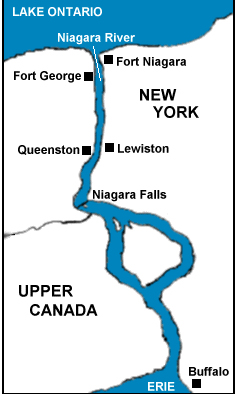
The history of Old Fort Niagara spans more than 300 years. During the colonial wars in North America a fort at the mouth of the Niagara River was vital, for it controlled access to the Great Lakes and the westward route to the heartland of the continent. The completion of the Erie Canal in 1825, however,
ended the strategic value of Fort Niagara.
The French established the first post here, Fort Conti, in 1679. Its successor, For Denonville (1687-88) was equally short lived. In 1726 France finally erected a permanent fortification with the construction of the impressive "French Castle." This building still stands.
Britain gained control of Fort Niagara in 1759, during the French & Indian War, after a nineteen-day siege. The British held the post throughout the American Revolution but were forced, by treaty, to yield it to the United States in 1796.
Fort Niagara was recaptured by the British in 1813 during the War of 1812.
The British launched their Niagara assault to retaliate against the destruction of Newark, Canada on December 10. American troops destroyed the Canadian city to deny shelter to advancing British forces, and, in so doing, left 400 city residents homeless, outraging both the British and Canadians.
|
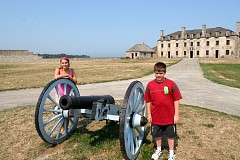
In the background is the French Castle.
In the final hours of December 18, 1813, approximately midway through the War of 1812, some 550 British soldiers crossed the Niagara River from Canada determined to seize Fort Niagara.
Fort Niagara expected a British strike following the Newark incident but was caught unprepared on the night of the attack. Fort commander Nathaniel Leonard was miles away in Lewiston visiting family, and the garrison's picket soldiers, stationed nearby at Youngstown, had retreated indoors to escape the cold. According to the re-enactors (one of whom is shown here), Leonard was an incompetent drunk.
|
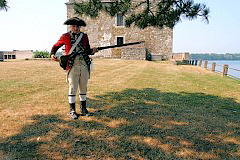
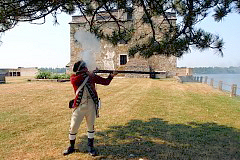
Commander Leonard couldn't remember new passwords, so the password was never changed.
After disarming the Youngstown pickets without a shot, the British advanced silently to the fort gate, arriving just as it opened to receive an American guard. Also knowing the password, the British pushed past the entrance and attacked. They passed the inner gate the same way, but an alert sentry there raised the alarm. It was too late to stop the British from rushing in.
|
|
The British found the majority of the fort's 433 soldiers asleep.
The defenders barricaded themselves inside the south redoubt of the fort and held off repeated attempts to break into the building. However, when they refused demands they surrender, the British commander offered no quarter to the defenders. Upon forcing their way into the building, the infamous order was given to "Bayonet the whole".
The defenders suffered 65 killed, most while no longer resisting. Captain Leonard was captured at his home several miles away. This most likely saved his life, as subsequently for his incompetence a sentence of death was
pronounced upon him by the Americans. Only six of the attackers were killed and 5 wounded.
|
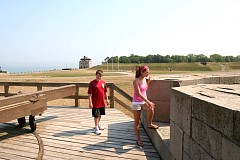
From Fort Niagara, the British marched on to destroy Youngstown, Lewiston, Manchester, Fort Schlosser, Black Rock, and Buffalo. While America countered these losses on other fronts, denying the British a sizable lead in the war, control of Fort Niagara allowed the British to dominate the Niagara River and regulate access to the Great Lakes where fighting continued.
|
|